Ata-ul-Haye Nasir, Ahmadiyya Archive & Research Centre
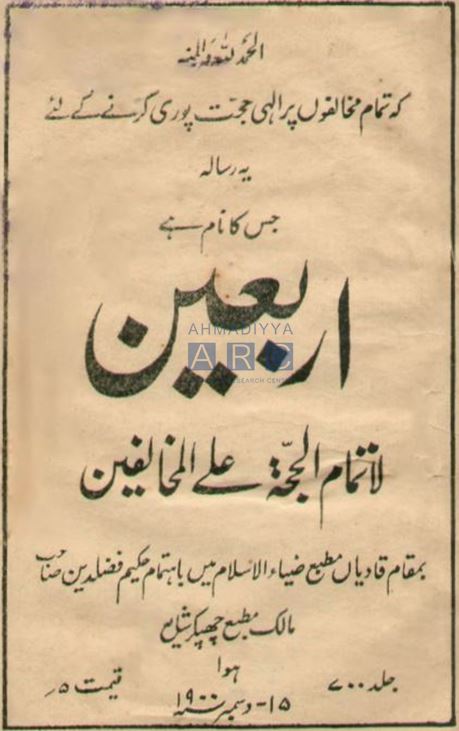
The later part of the 19th century was an era that saw a rising tide of opposition to Islam. In particular, the Christian and Arya clergymen, supported by their press, were running a malicious campaign against Islam. They were objecting to the teachings of the Holy Quran and attempting to malign the blessed character of the Holy Prophet Muhammadsa. At that juncture, Hazrat Mirza Ghulam Ahmadas of Qadian undertook to defend Islam, prove the magnificence of the Holy Quran and highlight the blessed character of the Holy Prophetsa.
This article endeavours to focus on the Indian press of the year 1900 and the Promised Messiah’sas series of tracts, titled “Arba‘in (Li Ittmamil-Hujjati ‘Alal-Mukhalifin)”, commencing in July 1900.
Arba‘in’s English translation has recently been published and was made available for the first time on this year’s Jalsa Salana UK. It was mentioned by Hazrat Amirul Momineenaa in his second-day address at the Jalsa Salana UK 2024.
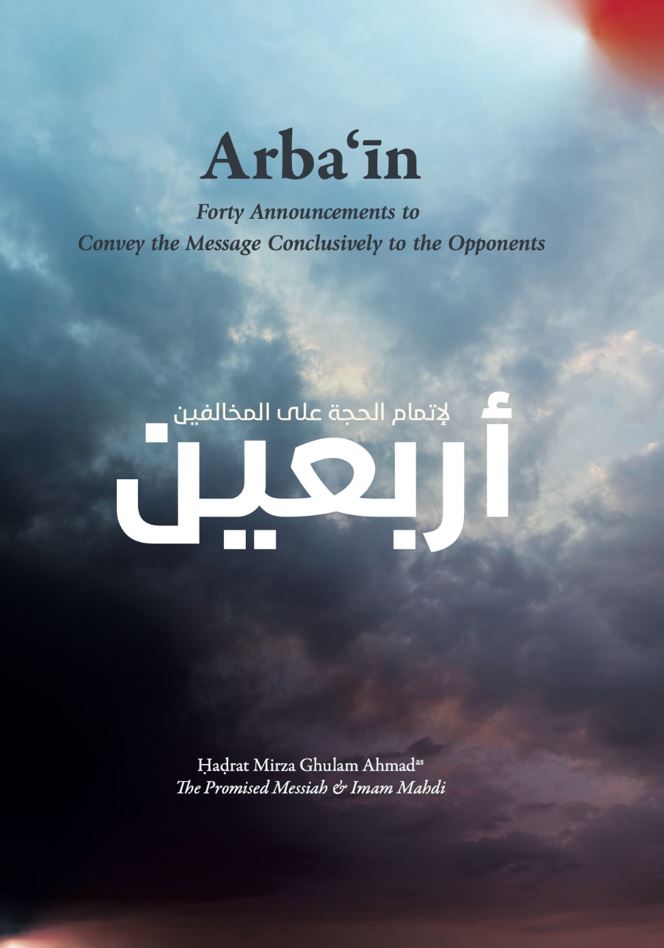
The year 1900 was a very significant one. In addition to the publication of Arba‘in, the Promised Messiahas announced the construction of Minarat-ul-Masih, issued the edict regarding Jihad, and challenged many opponents, such as the Bishop of Lahore and Pir Mehr Ali Shah of Golra.
Unfortunately, while the opponents of Islam were making all possible efforts to tarnish Islam, the Muslim clerics were also leaving no stone unturned in opposing the Promised Messiahas. However, this great champion of Islam bravely stood on this battlefield to defend Islam.
Announcement about Arba‘in
On 23 July 1900, the Promised Messiahas wrote an ishtihar – published in Al Hakam on 9 August 1900, exactly 124 years ago – and announced that he intended to publish 40 tracts to conclusively communicate the truth to the opponents (itmam al-hujjah), particularly the Muslim clerics, Christian missionaries and the Arya Samajists. This first tract was titled “Arba‘in Number 1”. Huzooras announced that after this tract, each tract would be published fortnightly, provided there was no hindrance of any kind, until the 40 tracts were completed or until an opponent came into the field with a pure intention and manifested any sign similar to Hazrat Ahmadas.
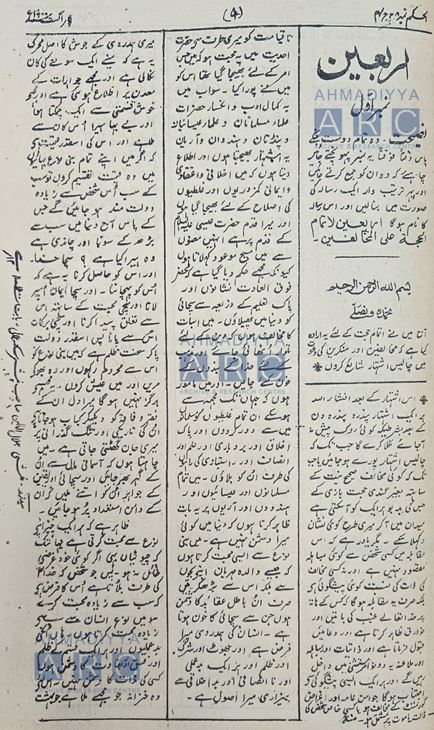
In this first tract, the Promised Messiahas addressed the opposing clergymen and reiterated his claim of being a ma‘mur (God’s appointee) and stated that the objective behind his advent is to uplift morality, reform beliefs and remove weaknesses of faith. He said that he has been commanded by God Almighty to spread the Truth by manifesting heavenly signs and righteous teaching. (Al Hakam, 9 August 1900, p. 4)
Opposition from the press
While Huzooras was inviting all clergymen to seek the truth and while he was proving the truthfulness of Islam, we find that it was a time when not only the opponent clergy, but the press too was leaving no stone unturned in opposing the Promised Messiahas. If we glance at the opponent press in the year 1900 alone, we find a huge storm of opposition against one single person — the God’s Appointee and the Saviour of mankind in the Latter Days. The prominent among the Muslim press was The Paisa Akhbar of Lahore and Sat Dharam Pracharak among the Arya press, while the Nur-i-Afshan of Ludhiana was leading the Christian rhetoric.
Inflammatory articles by Nur-i-Afshan before Arba‘in
It was a practice of the Christian newspaper, Nur-i-Afhsan of Ludhiana, to publish harsh and abusive articles against the Promised Messiahas, and the year 1900 was also no exception.
Around three months prior to Hazrat Ahmad’sas above-mentioned ishtihar, the Nur-i-Afshan published an article by a person named J.K., titled “Yasu ke Masih honay mein mukhalif ki mukhalifat” — The opponent’s opposition to Jesus being the Messiah, in which it was falsely asserted that among the Muslims, the Promised Messiahas was the biggest opponent of Jesusas. Addressing the Promised Messiahas, he wrote:
“You have staunchly opposed Jesus; it is incumbent upon you to believe Jesus the Messiah to be God, and accept him in order to attain a [spiritual] life.” (Nur-i-Afshan, 6 April 1900, p. 4)
The author of the article continued by using a harsh tone and wrote that in the past, the deniers of Jesus have received a strong response from the Christians and punishment from God as well. (Ibid.)
The fact is that the Promised Messiahas, in accordance with the Quranic teaching, considered Jesusas to be a prophet of Allah. He did not oppose him; however, he certainly opposed the false belief of the Christians and contemporary Muslims about Jesusas being alive in heaven. He announced after receiving divine revelation that Jesusas had passed away and would never return to the world. Moreover, as per the divine revelation, he claimed to be the Promised Messiah and Mahdi.
For more details on this, see “Hazrat Ahmad’s claim to be the Promised Messiah and opposition from the religious clergy and press”, at alhakam.org (19 April 2024).
In the same issue, another article was published titled “Masihi Mazhab Hind mein aur uska aainda tasallut” – Christianity in India and its future rule – by some H. Golaknath of Phillaur, in which he wrote that “a new Muhammadiyyat has appeared, which has commenced through Mirza Ghulam Ahmad”. (Nur-i-Afshan, 6 April 1900, p. 5)
The author then mentioned the Promised Messiah’sas prophecies in relation to the plague and used inappropriate and abusive language. (Ibid.)
The same newspaper published an article by Abul Fazl on 20 April 1900, in which he used inappropriate comments about the Holy Prophet Muhammadsa and the Promised Messiahas as well. He asserted that the Muslims were unable to prove any of the miracles manifested by the Holy Prophetsa and attempted to give a false impression that the Promised Messiahas could also not prove his miracles. (Nur-i-Afshan, 20 April 1900, pp. 5-6)
In the same issue, another article by Ramanand Anwar asserted that the Promised Messiahas wrote lengthy articles in relation to the miracle of the splitting of the moon but could not prove the Prophet Muhammad’ssa miracles. (Ibid., p. 6)
The truth is that the arguments and proofs that were presented by the Promised Messiahas in his writings, particularly Surma-e-Chashm-e-Arya in 1886, were so powerful and solid that no Arya had any courage to refute those, despite being challenged in the said book.
For more details, see “Anti-Islam rhetoric before and after Surma-e-Chashm-e-Arya: A glimpse into the Indian press”, at alhakam.org (5 May 2024).

Another point which must be noted by the opponents of the Promised Messiahas is that all these abuses and harsh comments towards him were only due to the fact that he was seen as the biggest defender of Islam and all opponents of Islam were putting every possible effort to down him, but they were helpless and thus, forced to use such inappropriate and vile language in desperation.
Minarat-ul-Masih: Comments of Akhbar-i-’Am and Koh-i-Nur
On 28 May 1900, the Promised Messiahas published an ishtihar, expressing his intention of constructing a minaret called “Minarat-ul-Masih” in the courtyard of the Aqsa Mosque in Qadian, as a physical and literal fulfilment of the Holy Prophet’ssa prophecy about the white minaret. He mentioned its details and the importance of fulfilling this prophecy and called the attention of Ahmadis towards contributing to a fund for the construction of this minaret. (Majmu‘ah-e-Ishtiharat [2019], Vol. 3, pp. 49-62)
Upon this, Akhbar-i-‘Am and Koh-i-Nur of Lahore published articles on 5 and 24 July 1900, respectively. These articles incorporated particular perspectives pertaining to the Promised Messiahas or his claims, which seemingly stemmed from the authors’ individual comprehension or convictions.
The Indian Newspaper Reports mentioned the article by Akhbar-i-‘Am, and stated its details under the heading “The Mirza’s tower” (Indian Newspaper Reports, c1868-1942, Vol. 13, No. 29, p. 354). This article also mentioned the Promised Messiah’sas edict about the prohibition of Jihad with the sword, issued on 7 June 1900, titled “Deeni Jihad ki mumani‘at ka Fatwa Masih-e-Maud ki taraf se” – The edict of the prohibition of religious Jihad from the Promised Messiah. (Majmu‘ah-e-Ishtiharat [2019], Vol. 3, pp. 63-66)
Since the Koh-i-Nur of Lahore, dated 24 July 1900, had also commented on Minarat-ul-Masih, the Indian Newspaper Reports mentioned it under the heading “The Mirza and his followers”. (Indian Newspaper Reports, c1868-1942, Vol. 13, No. 33, pp. 417-418)
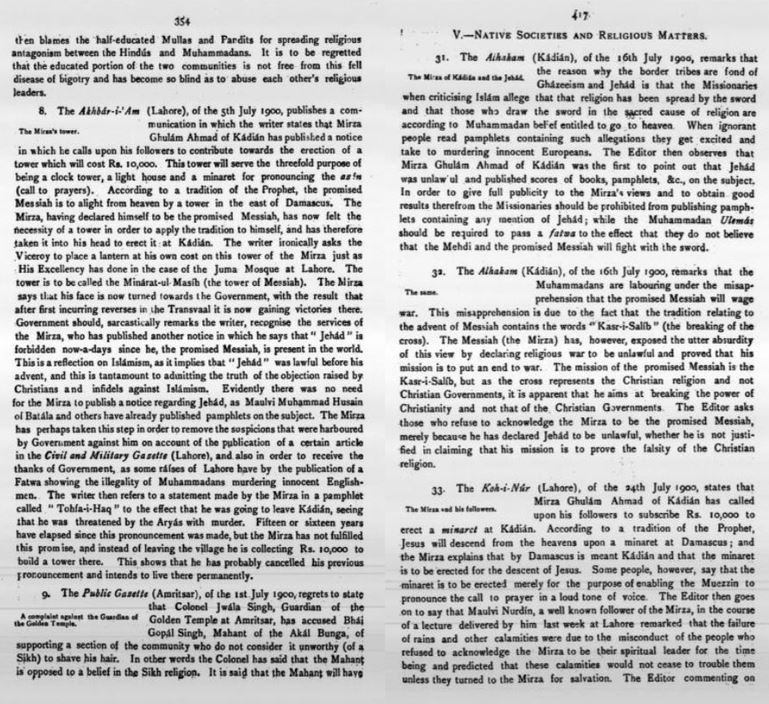
‘Miracle of Christianity’?
It is important to mention here that on 27 July 1900, the Nur-i-Afshan published an unnamed article in which it mentioned that the editor of an American Christian newspaper had come to India upon seeing the prevailing problems in India with an aim to personally assess the situation. The author wrote that the American Christian had sacrificed his own comfort and facilities available to him in his home country and accepted to face all kinds of hardships here in India, just for the betterment of mankind. It was stated that he did not come just because of Christianity, but rather, it was nothing else than human sympathy and love. He continued:
“The Hindus and Muslims ought to ponder over this miracle of Christianity. It is my desire that Mirza Qadiani — who is very proud of the power of his pen and often demands miracles from the Christians — shall look at this miraculous act of Christians, and remain silent until he manifests Messianic attributes, just like the Christians.” (Nur-i-Afshan, 27 July 1900, p. 7)
The fact is that by that time, Allah the Almighty had already manifested hundreds of signs at the hands of Hazrat Ahmadas, which served as a great proof of the existence of Allah, blessings of the Holy Prophetsa and Islam’s superiority over all other religions. However, strangely, these “seekers of signs” pretended as if they had not seen any sign from this champion of Islam.
Indian Newspaper Reports about the Arba‘in Number 1
This first tract was published in Al Hakam on 9 August 1900. This issue of Al Hakam and the Promised Messiah’sas tract was mentioned in the Indian Newspaper Reports, under the heading “The prophet of Kadian”:
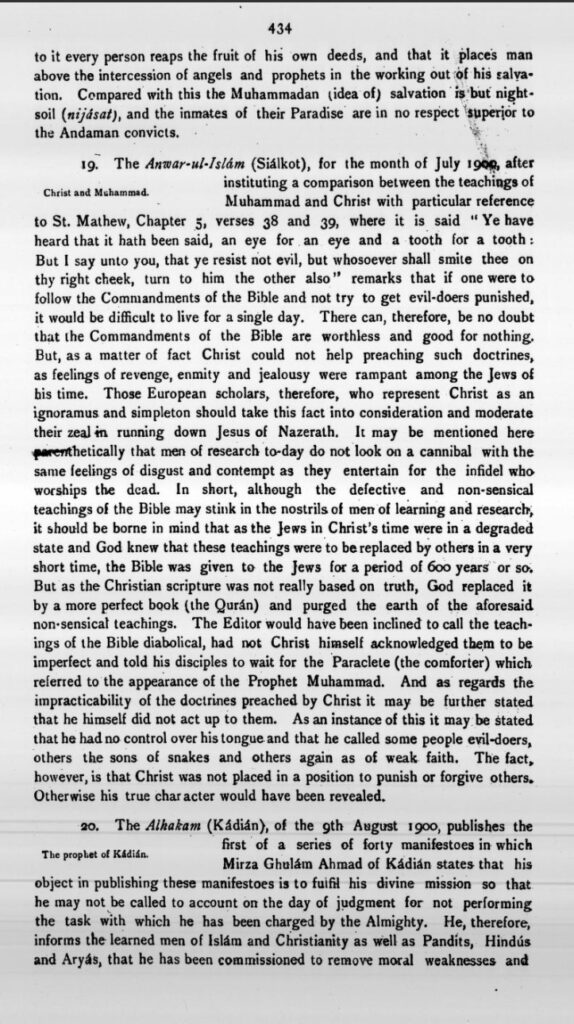
“The Al Hakam (Kadian), of the 9th August 1900, publishes the first of a series of forty manifestoes in which Mirza Ghulam Ahmad[as] of Kadian states that his object in publishing these manifestoes is to fulfil his divine mission so that he may not be called to account on the day of judgment for not performing the task with which he has been charged by the Almighty. He, therefore, informs the learned men of Islam and Christianity, as well as Pandits, Hindus and Aryas, that he has been commissioned to remove moral weaknesses and mistaken beliefs; that he will walk in the footsteps of Christ; and that it is for that reason that he is called the Promised Messiah. He has been directed to reveal and spread the Truth by means of miracles and holy teachings. He is opposed to the drawing of the sword and the shedding of blood for the sake of religion and has been commissioned to remove all such misapprehensions prevailing among the Muhammadans and call them to the path of morality, toleration, justice and righteousness. He bears enmity to no one; on the contrary, he loves everybody more tenderly than a mother loves her child. He is opposed only to false beliefs that are at variance with the Truth. It is his duty to sympathise with mankind and to express disgust at falsehood, polytheism, tyranny, &c., &c. The Mirza[as] then goes on to state that Islam is the only true and perfect religion, that the Koran [sic., Quran] is the only book that contains the best teaching and that Muhammad[sa] was the only man who lived an ideal life. The Mirza[as] calls himself the Promised Messiah and Mehdi, because, in the first place, the Prophet[sa] himself called him by that name and, in the next, because the Almighty, in direct communion with the Mirza[as], addressed him by those titles. Moreover, the moral requirements of the age demand that he should be called by such a name. The Mirza[as] claims the power of working miracles and asserts that his prayers are granted by God and that he knows things that are to happen in the future. If the world can produce another man who can equal him in any of these things, then the Mirza[as] is a most consummate liar. The Mirza[as] ridicules the assertion of Christian Missionaries that Muhammad[sa] never performed a miracle or made a prophecy and remarks that he was the only Prophet whose prayers were granted and whose prophecies were fulfilled. Nor is this all. Such things have been and are still being performed by the followers of Islam. Can the followers of other religions hold their own against the followers of Islam in this respect? A true religion leads its followers to a living God and those who firmly believe in Islam and follow the Mirza[as] shall acquire this inestimable boon.” (Indian Newspaper Reports, c1868-1942, Part 8, Vol. 13, No. 34, pp. 434-435)
Nur-i-Afshan’s response to Arba‘in Number 1
The Nur-i-Afshan of Ludhiana, dated 3 August 1900, criticised this tract published by the Promised Messiahas and used inappropriate language, and wrote under the heading “Mirza Ghulam Ahmad Qadiani”:
“Mirza Sahib has a great desire that the Muslims and Christians somehow accept him as the Promised Messiah. For this, he has initiated a new series of tracts, the first one of which has already been published.” (Nur-i-Afshan, 3 August 1900, p. 11)
Nur-i-Afshan further wrote that “in response to these manifestoes by Mirza Sahib, we only suffice to say that these manifestoes might induce the Muslims to acknowledge you as the Mahdi,” but the Christians would not give any importance and that the “Christians are very well aware of your life and know that your life is completely contrary to the nature of Jesus.” (Ibid.)
The Indian Newspaper Reports, under the heading “The Prophet of Kadian”, stated that Nur-i-Afshan “remarks that Mirza Ghulam Ahmad of Kadian has again taken to publishing manifestoes in the hope of persuading the Christians and the Muhammadans to acknowledge him to be the promised Messiah.” (Indian Newspaper Reports, c1868-1942, Part 8, Vol. 13, No. 34, p. 418)
Nur-i-Afshan’s response to Promised Messiah’s defence of Quran
One thing which stands out is that the Promised Messiahas was seen by the opponents of Islam as a major proponent of Islam and the Holy Quran, and thus, they were making all possible attempts to refute his arguments in favour of Islam. They left no stone unturned in their efforts, though resulting in utter failure, to veil the magnificence of the Holy Quran that was being highlighted by the Promised Messiahas in his writings and discourses.
For instance, on 31 August 1900, the Nur-i-Afshan of Ludhiana, published an article by H Golaknath, in which he wrote:
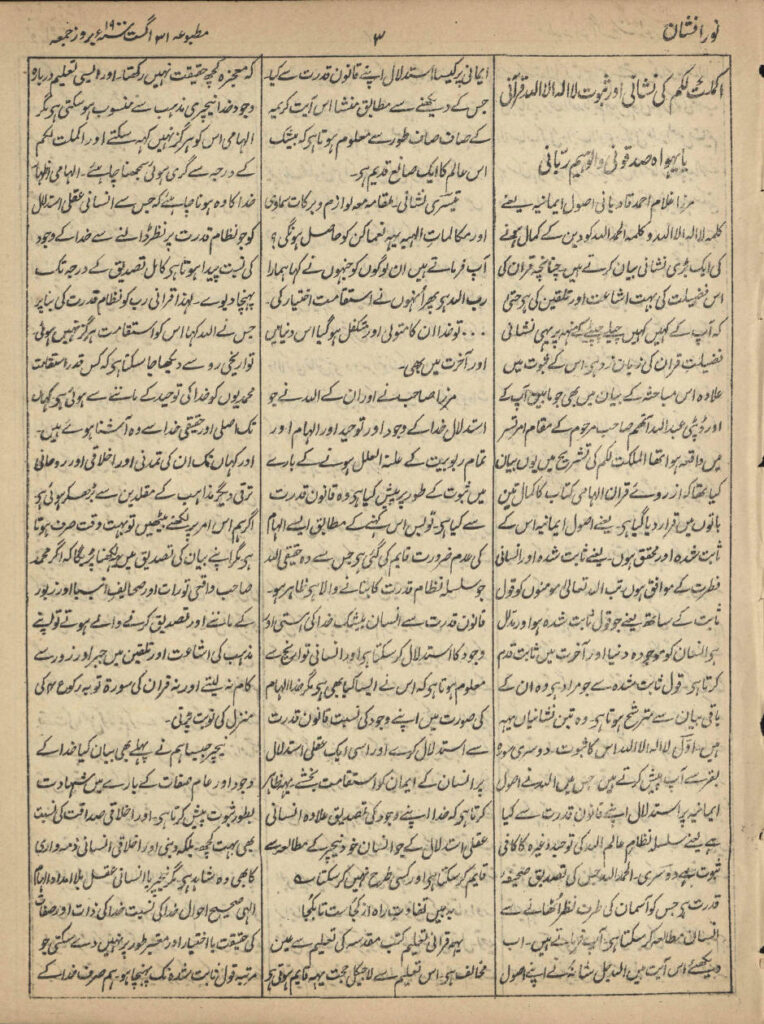
“Mirza Ghulam Ahmad Qadiani presents the fundamentals of the faith — meaning the kalima لا الہ الا اللّٰہ [there is none worthy of worship except Allah] and the kalima الحمد للّٰہ [All praise belongs to Allah] — to be a major proof of the completion of faith. Hence, he strongly propagates and teaches this superiority of the Quran, even to the extent that this very superiority of the Quran is mentioned by his [followers] too in some places. In addition, another proof which he had presented while commenting on اکملت لکم [Surah al-Maidah, Ch.5: V.4] during the debate with late Deputy Abdullah Athim Sahib in Amritsar, was that in accordance with the Quran, the criterion for the perfection of a Revealed Book is based on three points.
“‘Meaning that the basic principles of faith of that Book must be solid and proven,’ that is, they are proven and ‘the nature of man accepts them,’ it is then that ‘Allah strengthens the believers with the Word that is firmly established—that is to say, a word that is proven and well argued—both in the present life and in the Hereafter. [The Holy War (Jang-e-Muqaddas), pp. 61-62].’
“As far as the meaning of a firmly established Word is concerned, it has been explained in his further statement. Those three signs are: Firstly, لا الہ الا اللہ, whose proof he presents from the second Surah [of the Holy Quran] al-Baqarah [2:165], that is, Allah ‘has argued within this verse in favour of this principle of faith of His, from His law of nature,’ meaning that the system of the universe is a sufficient proof of Allah’s Tawhid [Oneness], etc. [The Holy War (Jang-e-Muqaddas), p. 63]
“The second [sign] is الحمد للہ [All praise belongs to Allah], that is authenticated from the manifestations of nature [sahifa-e-qudrat], which mankind could witness upon pondering over the heavens. He states:
“‘Now, look how Allah, the Lord of Glory, has argued within this verse in favour of this principle of faith of His, from His law of nature’, and ‘by looking at which, in clear accord with the intent of this noble verse, it becomes very clearly evident that, without a doubt, there is an Eternal Creator of this world.’ [Ibid.]
“The third sign is ‘meeting with Allah, the Lord of Glory, together with all its accompaniments by way of heavenly blessings and Divine converse.’ [Ibid., pp. 64-65]
“Who would be the recipients of these blessings? He states, ‘Those who say, “Our Lord is Allah,” and then they adopted steadfastness’ … and God became their Protector and Guardian in this life and the Hereafter as well. [Surah Ha Mim as-Sajdah, Ch. 41: V. 31-32]. [Ibid., p. 65]” (Nur-i-Afshan, 31 August 1900, p. 3)
The author then attempts to refute the above-mentioned arguments, and before proceeding to his arguments, states:
“I will shortly narrate about the principles or the principles of faith which are often mentioned by Mirza Ji and then comment on اکملت لکم in light of the Sacred Scriptures.” (Ibid., p. 4)
The fact is that despite all their efforts, for instance, these articles in Nur-i-Afshan, they were unable to refute the majestic arguments presented by the Promised Messiahas in his writings and discourse.
The Paisa Akhbar’s one-sided articles
In 1900, The Paisa Akhbar of Lahore was publishing one-sided articles and using inappropriate language in relation to the Promised Messiahas, particularly when reporting about his challenge to Pir Mehr Ali Shah of Golra in its issues of 1 and 8 September 1900.
Moreover, on 29 December 1900, it published a review of Munshi Ilahi Bakhsh of Lahore’s book Asa-e-Musa whichhe wrote against the Promised Messiahas, and mentioned that this book was written in response to the Promised Messiah’s book Zuroorat-ul-Imam (The Need for Imam). The article’s tone was very harsh and one-sided.
In relation to that book of Ilahi Bakhsh, the Promised Messiahas had stated:
“I received the book of Munshi Ilahi Bakhsh Accountant, Asa-e-Musa, in which he has made personal attacks on me, merely based on suspicion and against some of God’s true and sacred foretellings with utter haste.” (Majmu‘ah-e-Ishtiharat [2019], Vol. 3, p. 155 [footnote])
Sat Dharam Pracharak’s articleand response by Akhbar-i-‘Am and Al Hakam
An Arya newspaper, Sat Dharam Pracharak, in its 14 September 1900 issue, published an article in response to the Arba‘in and criticised it in very abusive and harsh language.
The Indian Newspaper Reports, mentioned an article by Akhbar-i-‘Am, under the heading “The Aryas and the Mirza of Qadian”, which criticised Sat Dharam Pracharak’s article:
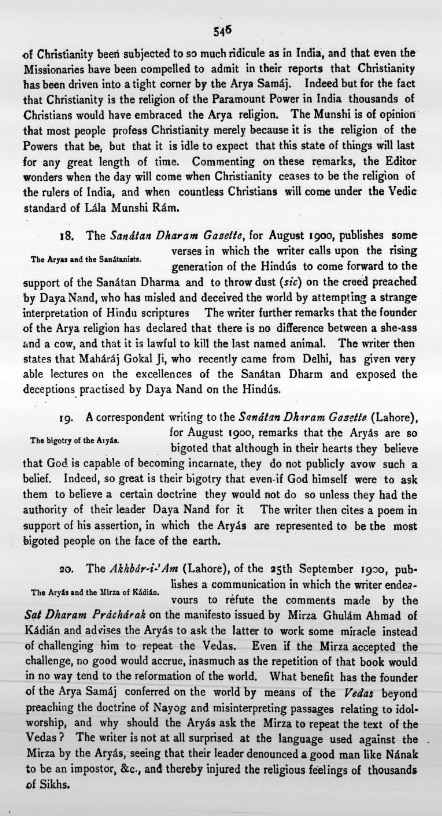
“The Akhbar-i-‘Am (Lahore), of the 25th September 1900, publishes a communication in which the writer endeavours to refute the comments made by the Sat Dharam Pracharak on the manifesto issued by Mirza Ghulam Ahmad[as] of Kadian and advises the Aryas to ask the latter to work some miracle instead of challenging him to repeat the Vedas. Even if the Mirza accepted the challenge, no good would accrue, inasmuch as the repetition of that book would in no way tend to the reformation of the world. What benefit has the founder of the Arya Samaj conferred on the world by means of the Vedas beyond preaching the doctrine of Nayog and misinterpreting passages relating to idol-worship, and why should the Aryas ask the Mirza to repeat the text of the Vedas? The writer is not at all surprised at the language used against the Mirza by the Aryas, seeing that their leader denounced a good man like Nanak[rh] to be an impostor, &c., and thereby injured the religious feelings of thousands of Sikhs.” (Indian Newspaper Reports, c1868-1942, Part 8, Vol. 13, No. 41, pp. 546)
Al Hakam, in its 16 September 1900 issue, wrote a detailed article in response to the article by Sat Dharam Pracharak. The Indian Newspaper Reports included a summary of this Al Hakam article as well. (Ibid., p. 547)
Arba‘in Number 2 and Arba‘in Number 3
Arba‘in Number 2 was published on 27 September 1900. In the beginning, Huzooras stated that the jealousy, glory and honour of God Almighty demanded that He once again manifest Himself to mankind. Hence, God Almighty has appointed him at the beginning of the 14th century for the revival of Faith and for propagating the true understanding (ma‘rifat), and that with the support and grace of Allah, heavenly signs are being manifested on his hand. The Promised Messiahas swore in the name of the Gracious and Mighty God that he is from Him and has come at the appointed time with His Will. Huzooras declared that Allah the Almighty is with him at every step he takes and He will not cause him any failure, nor will He destroy his Jamaat until He fulfils all of His plan that He has intended. (Arba‘in Number 2, p. 2; Ruhani Khazain Vol. 17, p. 348)
It is important to mention here that in this tract, the Promised Messiahas mentioned various revelations he received from God Almighty, including the following revelation that was received in 1865:
ثمانين حولا او قريبا من ذالک او تزيد عليہ سنينا
“Your age will be 80 years, a few years less or some years more.” (Arba‘in Number 2, p. 31; Ruhani Khazain Vol. 17, p. 380)
This revelation was also mentioned in Arba‘in Number 3. (Ruhani Khazain, Vol. 17, p. 419)
Arba‘in Number 4
The Promised Messiahas wrote the fourth tract, titled “Arba‘in Number 4”. Towards the end, Huzooras stated under the heading “Ittilaa” – announcement:
“I had expressed my plan to publish forty separate flyers of this treatise, Arba‘in. I had imagined that I would only print single-paged flyers, which could sometimes be one and a half pages long or, at the most, two pages long, and occasionally I would write three to four-page flyers. But it so happened that I ended up writing these flyers differently. [Arba‘in] Numbers 2, 3 and 4 turned out as small booklets. As a result, the book became almost seventy pages long; thus, my initial intent has been realized. I have, therefore, ended these treatises at Number 4 and no more will be published in the future. Just as our God, the Lord of Honour and Glory, had initially prescribed fifty daily Prayers but later reduced the number and established five a substitute to fifty, in the same way, following the tradition of our Benevolent Lord, I declare the number four a substitute for forty by way of reducing the burden on the readers and end this writing with a few words of advice to my Community.” (Arba‘in [English], p. 143)
Once Huzooras had finished writing the fourth tract, he published all of these four tracts in a book form on 15 December 1900.
Conclusion
The opponents of the Promised Messiahas often allege that he did not fulfil his promise of writing 40 tracts and just published four. However, the above-mentioned words of the Promised Messiahas are sufficient refutation to such notions. Since the purpose behind writing these tracts had been fulfilled with just four tracts, there was no need to continue this series.
As far as the opposition in the year 1900 is concerned, there was an unprecedented rise in the opponents’ efforts to halt the Promised Messiah’sas mission. However, divine help and succour was with him at all times, hence, he continued to succeed in his mission to prove the magnificence of Islam and the Holy Quran, and to highlight the blessed character of the Holy Prophet Muhammadsa.

